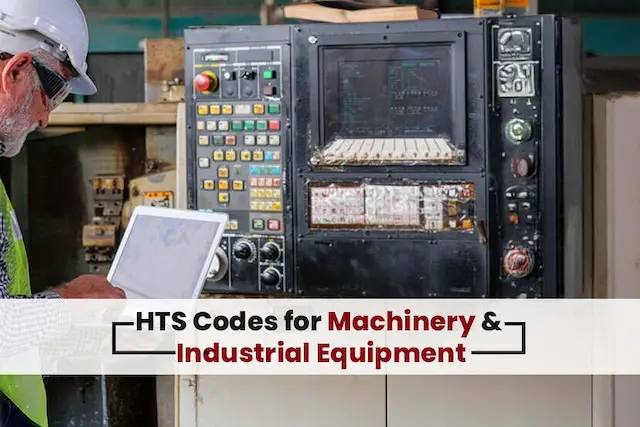
HTS Code LookupFind Tariff Codes by Product or Number
Search the Harmonized Tariff Schedule by entering a product name or HTS code to get duty rates, descriptions, and classification details.
HTS Code: US Specified Tariff Coding System
During any international trade, precision and accuracy matter a lot while dealing with different types of products. Similarly, while trading with the US, whenever a product crosses the border, it must be classified under the specific code, also known as the HTS code. The HTS code full form is Harmonized Tariff Schedule, which acts as a standardized code that helps in determining the traded products, the appropriate classification of products, duty and tariff calculation on specific products, easy for customs clearance, and even easier to regulate any compliance.
What exactly does HTS code mean?
The comprehensive way to understand the HTS code meaning is very simple. It is considered to be an effective harmonized tariff schedule code used for the appropriate product classification while exporting to the USA. It is also based on the HS code system, which was created by the World Customs Organization, specified for every nation. Let's understand the classification of the 10-digit code present in the Harmonized Tariff Code.
Comprehensive Classification of HTS Code Structure
- First 2 digits of HTS: It is used (I and II numbers) for identifying the broad category in which the specified product falls.
Example: 85 is used for electrical machinery and equipment. - Global Standard: HSN codes are used worldwide to classify products for customs and taxation purposes.
- Next 2 digits of HTS: The number (III and IV) helps in specifying a more precise group of the product.
Examples: In 8501, 01 is used for products falling into the category of electric motos and generators. - Next 2 digits of HTS: The other 2 digits of the HTS code (V and VI) are used for specifying the further details of the products.
Examples: In 850110, 10 defines more specific details about the motors for its output, such as less than or equal to 37.5 watts. - Next 2 digits of HTS: These two numbers (VII and VIII) are used as national subheading and curated as per the country eligibility and specific to the United States, which is used for calculating tariff and duty.
Example: In the HTSUS code, 85011020, 20 is used for extremely specific product details like fractional horsepower motors, and the country can easily specify the duty and tariff. - The last 2 digits of HTS US: Now these two optional numbers (IX and X) are used for providing information about the US-specific trade statistics and data tracking. For example, 85011020(00).
Key facts of the US HTS code digits
For a more comprehensive and overall understanding of the US HS code, have a look at the facts below about it.
- The first 6 digits of the HTS code are similar to the HSN code, which can be recognized globally.
- The Last 4 digits of the US HTS code are used for specifying the US-specific entitlements, tariff, and duty on the chosen product.
- The HTS code is handled and maintained by the US International Trade Commission.
What are the objectives of the HTS code?
It is the prime responsibility of traders and businesses to opt for the accurate HS Code search process at a trustworthy platform like Credlix. However, you should be aware of the US HTS code objectives, such as:
- Standardization Classification of Goods
The harmonized tariff schedule code allows an individual to identify the correct information about the goods and products to interpret while trading with another country. - Smooth International Trade
It helps the traders and businesses to clear customs without any hindrances, resulting in easy clearance and identification of the products and goods. - Determination of Import and Export Tariffs and Duties
Using an appropriate harmonized code lookup process helps you in identifying the export and import duties and tariffs in the USA while trading different types of goods. It provides authentic information on duties, taxes, and even tariffs. - Ensure Right Trade Policies
It also helps the US government and businesses to understand the right type of trade policies and avoid restrictions and bans for any special trade agreements. - Collecting Trade Statistics
Using the HTS code by the USA customs department or any business helps to track the authentic and reliable data and stats of specific trading products and goods. It allows the organization and government to work efficiently and understand economic analysis and business market research. - Determination of Import and Export Tariffs and Duties
Using an appropriate harmonized code lookup process helps you in identifying the export and import duties and tariffs in the USA while trading different types of goods. It provides authentic information on duties, taxes, and even tariffs. - Adhering to Compliance and Trading Laws
It is necessary to find harmonized codes on reliable platforms to prevent any kind of fraudulent and misclassification of trading products. It makes it easy to tackle the challenges and fight against illegal trades and smuggling scenarios. - Supporting Trade Negotiations
HTS codes ensure the proper and smooth flow of every trade business through which you can easily negotiate on the tariffs and trade agreements
What is the Common Difference Between HSN and HTS codes?
HS code and HTS code are mainly used by traders, seem too same, but practically they have slight differentiation. When it comes to the HS code list, it is a 6-digit code approved by the International Trade Organization, largely used by every country, whereas HTS codes are 8 to 10-digit US-specified codes applied while trading with the USA. Let’s compare both:
- HSN code consists of 6 digits, whereas HTS code consists of 8 to 10 digits.
- HSN codes are mainly used for trading with several countries, whereas HTS codes are used for US imports only.
- HSN is authorized by the World Customs Organization, and HTS is authorized by the United States International Trade Commission.
- HSN helps in identifying basic clarification on products, whereas HTS provides detailed information on tariffs and taxes in the US trade.
How Can You Find the Accurate HTS Code?
The basic and crucial step for the US's importing and exporting requires proper classification of the HTS code for a specific product. You need to be very specific for the HTS code search to eliminate the risk of misclassification, wrong duties, and avoid penalties. Therefore, opting for a genuine platform like Credlix is the best option to find the HTS code. At our platform, you will find the complete database of all HTS codes, while offering an automated HTS code lookup tool to fetch the accurate and precise codes, assisting in cost-effective and smooth trade.
Common Mistakes to Avoid During HTS Code Search?
It is very necessary to be specific while searching the HTS code list according to your product or goods’ requirements. Misclassification of the HTS code may lead to small but impactful errors that can lead to damage to your trade opportunities. Therefore, you need to avoid some common mistakes while searching the HTS tariff code, such as:
- Searching the codes without proper information and research work
- Trying to copy the classification of competitors' strategy of HTS search.
- Opting for unauthorized and outdated HS and HTS codes.
- Overlooking the more specific goods and products for better classification.
- Being confused between HSN codes and HTS codes.
What can be the consequences of wrong US HTS codes?
Using the wrong HTS code may lead to overpaying the penalties and delays in trade with the US. Even sometimes, it can revoke your business trade, and goods might get seized. Let's understand the common yet effective consequences of relying on the wrong harmonized tariff code:
- It may lead to overpayment of duties and tariffs.
- Trying to copy the classification of competitors' strategy of HTS search.
- Increases the probability of custom delay and misinterpretation.
- High chances of getting fined and legal penalties.
- Can lose the trust of the customers and business partners.
Tips to avoid these consequences
- Always find the HTS code through a trustworthy platform like Credlix.
- Be specific to every digit of the code to fetch the appropriate details of products and goods.
- Cross-check and compare the codes thoroughly.
- In case of any updates or amendments to duties and tariffs, you should adhere to all essential information. Example: “The USA imposed a 25% tariff on Indian traders and businesses”
- Keep a track record of every documentation while searching for the HTS code.
Chapter | Commodities |
Section 1 | |
Live animals | |
Meat and edible meat offal | |
Fish and crustaceans, molluscs and other aquatic invertebrates | |
Dairy produce; birds' eggs; natural honey; edible products of animal origin, not elsewhere specified or included | |
Products of animal origin, not elsewhere specified or included | |
Section 2 | |
Live trees and other plants; bulbs, roots and the like; cut flowers and ornamental foliage | |
Edible vegetables and certain roots and tubers | |
Edible fruit and nuts; peel of citrus fruit or melons | |
Coffee, tea, maté and spices | |
Cereals | |
Products of the milling industry; malt; starches; inulin; wheat gluten | |
Oil seeds and oleaginous fruits; miscellaneous grains, seeds and fruit; industrial or medicinal plants; straw and fodder | |
Lac; gums, resins and other vegetable saps and extracts | |
Vegetable plaiting materials; vegetable products not elsewhere specified or included | |
Section 3 | |
Animal or vegetable fats and oils and their cleavage products; prepared edible fats; animal or vegetable waxes | |
Section 4 | |
Preparations of meat, of fish or of crustaceans, molluscs or other aquatic invertebrates | |
Sugars and sugar confectionery | |
Cocoa and cocoa preparations | |
Preparations of cereals, flour, starch or milk; pastrycooks' products | |
Preparations of vegetables, fruit, nuts or other parts of plants | |
Miscellaneous edible preparations | |
Beverages, spirits and vinegar | |
Residues and waste from the food industries; prepared animal fodder | |
Tobacco and manufactured tobacco substitutes | |
Section 5 | |
Salt; sulphur; earths and stone; plastering materials, lime and cement | |
Ores, slag and ash | |
Mineral fuels, mineral oils and products of their distillation; bituminous substances; mineral waxes | |
Section 6 | |
Inorganic chemicals; organic or inorganic compounds of precious metals, of rare-earth metals, of radioactive elements or of isotopes | |
Organic chemicals | |
Pharmaceutical products | |
Fertilisers | |
Tanning or dyeing extracts; tannins and their derivatives; dyes, pigments and other colouring matter; paints and varnishes; putty and other mastics; inks | |
Essential oils and resinoids; perfumery, cosmetic or toilet preparations | |
Soap, organic surface-active agents, washing preparations, lubricating preparations, artificial waxes, prepared waxes, polishing or scouring preparations, candles and similar articles, modelling pastes, ‘dental waxes’ and dental preparations with a basis of plaster | |
Albuminoidal substances; modified starches; glues; enzymes | |
Explosives; pyrotechnic products; matches; pyrophoric alloys; certain combustible preparations | |
Photographic or cinematographic goods | |
Miscellaneous chemical products | |
Section 7 | |
Plastics and articles thereof | |
Rubber and articles thereof | |
Section 8 | |
Raw hides and skins (other than furskins) and leather | |
Articles of leather; saddlery and harness; travel goods, handbags and similar containers; articles of animal gut (other than silkworm gut) | |
Furskins and artificial fur; manufactures thereof | |
Section 9 | |
Wood and articles of wood; wood charcoal | |
Cork and articles of cork | |
Manufactures of straw, of esparto or of other plaiting materials; basketware and wickerwork | |
Section 10 | |
Pulp of wood or of other fibrous cellulosic material; recovered (waste and scrap) paper or paperboard | |
Paper and paperboard; articles of paper pulp, of paper or of paperboard | |
Printed books, newspapers, pictures and other products of the printing industry; manuscripts, typescripts and plans | |
Section 11 | |
Silk | |
Wool, fine or coarse animal hair; horsehair yarn and woven fabric | |
Cotton | |
Other vegetable textile fibres; paper yarn and woven fabrics of paper yarn | |
Man-made filaments; strip and the like of man-made textile materials | |
Man-made staple fibres | |
Wadding, felt and nonwovens; special yarns; twine, cordage, ropes and cables and articles thereof | |
Carpets and other textile floor coverings | |
Special woven fabrics; tufted textile fabrics; lace; tapestries; trimmings; embroidery | |
Impregnated, coated, covered or laminated textile fabrics; textile articles of a kind suitable for industrial use | |
Knitted or crocheted fabrics | |
Articles of apparel and clothing accessories, knitted or crocheted | |
Articles of apparel and clothing accessories, not knitted or crocheted | |
Other made-up textile articles; sets; worn clothing and worn textile articles; rags | |
Section 12 | |
Footwear, gaiters and the like; parts of such articles | |
Headgear and parts thereof | |
Umbrellas, sun umbrellas, walking sticks, seat-sticks, whips, riding-crops and parts thereof | |
Prepared feathers and down and articles made of feathers or of down; artificial flowers; articles of human hair | |
Section 13 | |
Articles of stone, plaster, cement, asbestos, mica or similar materials | |
Ceramic products | |
Glass and glassware | |
Section 14 | |
Natural or cultured pearls, precious or semi-precious stones, precious metals, metals clad with precious metal, and articles thereof; imitation jewellery; coin | |
Section 15 | |
Iron and steel | |
Articles of iron or steel | |
Copper and articles thereof | |
Nickel and articles thereof | |
Aluminium and articles thereof | |
Lead and articles thereof | |
Zinc and articles thereof | |
Tin and articles thereof | |
Other base metals; cermets; articles thereof | |
Tools, implements, cutlery, spoons and forks, of base metal; parts thereof of base metal | |
Miscellaneous articles of base metal | |
Section 16 | |
Machinery, mechanical appliances, nuclear reactors, boilers; parts thereof | |
Electrical machinery and equipment and parts thereof; sound recorders and reproducers, television image and sound recorders and reproducers, and parts and accessories of such articles | |
Section 17 | |
Railway or tramway locomotives, rolling stock and parts thereof; railway or tramway track fixtures and fittings and parts thereof; mechanical (including electromechanical) traffic signalling equipment of all kinds | |
Vehicles other than railway or tramway rolling stock, and parts and accessories thereof | |
Aircraft, spacecraft, and parts thereof | |
Ships, boats and floating structures | |
Section 18 | |
Optical, photographic, cinematographic, measuring, checking, precision, medical or surgical instruments and apparatus; parts and accessories thereof | |
Clocks and watches and parts thereof | |
Musical instruments; parts and accessories of such articles | |
Section 19 | |
Arms and ammunition; parts and accessories thereof | |
Section 20 | |
Furniture; bedding, mattresses, mattress supports, cushions and similar stuffed furnishings; lamps and lighting fittings, not elsewhere specified or included; illuminated signs, illuminated nameplates and the like; prefabricated buildings | |
Toys, games and sports requisites; parts and accessories thereof | |
Miscellaneous manufactured articles | |
Section 21 | |
Works of art, collectors' pieces and antiques | |
Section 22 | |
Special classification provisions | |
Temporary legislation; temporary modifications proclaimed pursuant to trade agreements legislation; additional import restrictions proclaimed pursuant to section 22 of the Agricultural Adjustment Act, as amended | |







